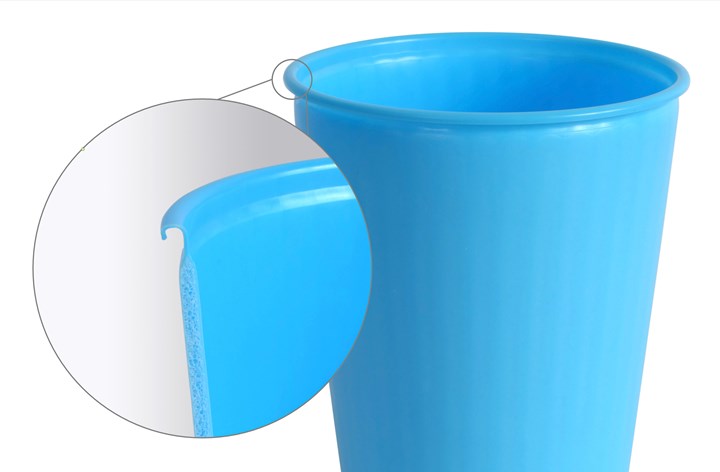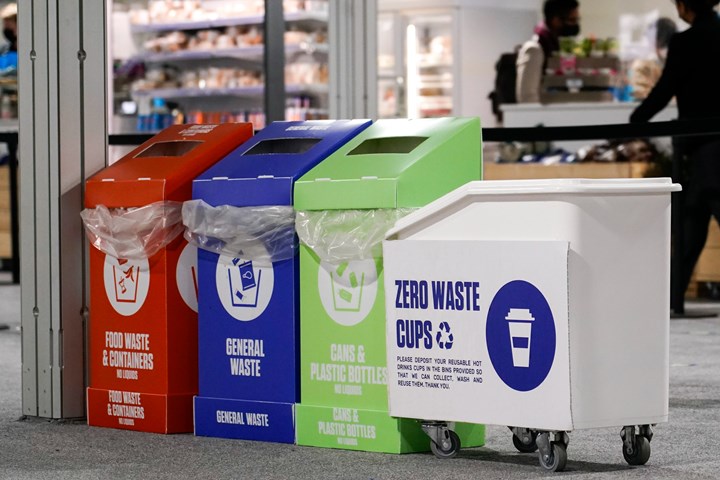EcoCore PP-Based Recyclable and Reusable ‘Zero-Waste’ Cups Used At COP26
Bockatech’s EcoCor foam core technology for lightweight and reusable packaging ‘starred’ at this year’s conference.
Within the last four years, we have reported on the patented EcoCore foam core technology for lightweight and reusable packaging from U.K.’s Bockatech. This included Bochatech’s 2020 partnership with Austria’s Borealis (U.S. office in Port Murray, N.J.), and Las Vegas-based Westfall Technik Inc., a global holding company that provides innovative plastics manufacturing solutions to the healthcare, packaging and consumer goods industries. That license agreement enables Westfall to promote Bockatech’s EcoCore technology to key prospects in the U.S., with options to extend the partnership to toolmaking and mass production for the nominated applications.

Free reusable and recyclable cups made with Bochatech’s EcoCore manufacturing technology ‘starred’ at the 2021 U.N. Climate Change Conference in Glasgow, also known as COP26. As previously reported, EcoCore creates PP packaging with skin-foam-skin walls in seconds — lowering costs, increasing strength, reducing material use, cutting cycle times, and boosting thermal protection. The patented aspect of the technology is what Bochatech refers to informally as “form controlled free expansion” (FCFE)--an area of foam molding design on which they have worked on for many years to allow for large density reductions.
What makes EcoCore different from normal foam molding is the speed—cycle times well below 10 sec. is claimed with density reduction of up to 70%. Also, EcoCore only needs modifications to the component design to work and uses existing molding machines as well as plastics, and blowing agents used can be either chemical or physical/gas.
The distinctive blue and white COP26 reusable Zero Waste Cups were used in place of single-use cups by the Scottish Event Campus food-service provider Levy, part of Compass Group. Cups are made with and Borealis PP and also feature PP reusable lids, keeping the whole container mono material to improve recyclability.
After use, cups are returned via collection bins and washed, using a Winterhalter wash system, ready to be used again.
The reusables were expected to save up to 250,000 single-use cups across two weeks of the conference. Against popular single-use dual-wall lined PE and PLA compostable paper cups, reusables made with EcoCore have shown a 20% to 30% reduction in CO2 eq after just two uses. After 30 uses, the reduction in CO2 eq increases to 80% to 85%. Using an EcoCore reusable only twice also halves the risk of containers polluting land and sea environments as litter. Using a cup thirty times reduces the risk by 1/30th.
Talking about the innovative reusables at the event, Bockatech CEO Henri Gaskjenn said, "We're excited to see cups made with our Greentech being used by leaders from around the world. The considerable cost of many reusables limits how food-service brands can use them, EcoCore creates low-cost durable cups that gives the freedom to offer reusables in a way that works best for businesses and their customers.That includes giving them away as they are at COP26."
The 250ml and 430ml COP26 cups were produced by MikoPac, part of Paccor. Although the event cups do not have branding, they can be supplied with PP in-mold labels (IML) for full color branding and to keep the solution monomaterial for easy recycling.

Related Content
Prices for PE, PS, PVC, PET Trending Flat; PP to Drop
Despite price increase nominations going into second quarter, it appeared there was potential for generally flat pricing with the exception of a major downward correction for PP.
Read MoreThe Fundamentals of Polyethylene – Part 1: The Basics
You would think we’d know all there is to know about a material that was commercialized 80 years ago. Not so for polyethylene. Let’s start by brushing up on the basics.
Read MoreThe Fundamentals of Polyethylene – Part 2: Density and Molecular Weight
PE properties can be adjusted either by changing the molecular weight or by altering the density. While this increases the possible combinations of properties, it also requires that the specification for the material be precise.
Read MoreFundamentals of Polyethylene – Part 6: PE Performance
Don’t assume you know everything there is to know about PE because it’s been around so long. Here is yet another example of how the performance of PE is influenced by molecular weight and density.
Read MoreRead Next
Lead the Conversation, Change the Conversation
Coverage of single-use plastics can be both misleading and demoralizing. Here are 10 tips for changing the perception of the plastics industry at your company and in your community.
Read MoreMaking the Circular Economy a Reality
Driven by brand owner demands and new worldwide legislation, the entire supply chain is working toward the shift to circularity, with some evidence the circular economy has already begun.
Read MoreBeyond Prototypes: 8 Ways the Plastics Industry Is Using 3D Printing
Plastics processors are finding applications for 3D printing around the plant and across the supply chain. Here are 8 examples to look for at NPE2024.
Read More

























